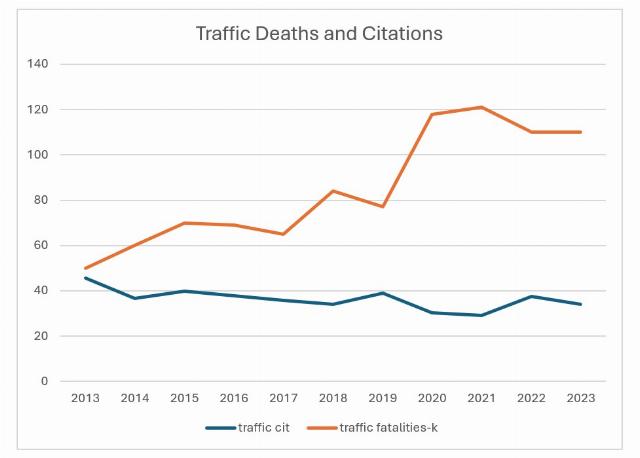Woke policies cost lives
Like many people around the country, I have noticed that the roads and highways of my town have become more dangerous and that the number of fatal crashes and hit-and-run incidents seemed to be more deadly and frequent. I became curious and dug into the data.
The information led to some conclusions that were obvious, but unpopular. The local police, politicians, and news outlets have no interest in exploring the problem from its source and instead offer study groups and costly infrastructure solutions rather that addressing the problem. I suspect that this dynamic is repeated in countless cities across the country.
Last month the Indianapolis city/county council announced a program to eliminate traffic-related deaths within the jurisdiction by the year 2035. The ambitious program is expected to develop plans over the coming year that will make the roads safer for pedestrians, cyclists and drivers and is expected to roll out improvements by 2026.
Like most government programs, it aims at a worthy goal. Also like most government programs, it ignores data that both illuminates the cause and suggests the solution.

The number of traffic-related deaths, adjusted for population growth, remained relatively static for decades until 2014 when that number jumped by 20% and started a trend upwards. 2014 also marked a change in practice by the IMPD (Indianapolis Metropolitan Police Department) and many law-enforcement agencies around the country in the wake of Michael Brown’s death in Ferguson, Missouri.
Michael Brown was killed while attacking police officer Darren Wilson and the early narrative was that he was shot while surrendering to the officer with his hands raised in the air. Despite being counterfactual, the early narrative was powerful and unrelenting and public pressure caused police agencies to pull back from police initiating traffic stops and other common law-enforcement practices. This rollback of law enforcement was termed “the Ferguson Effect’, and the IMPD fell in line.
Traffic-related deaths continued to remain high until 2020 when they spiked another 65% to 118, more than double what it was in 2013.
In addition to being the first year of the Covid era, 2020 will also be remembered for the death of George Floyd and the centering of the Black Lives Matter movement in the American consciousness. The subsequent riots, arson, and looting were bolstered by the slogan “all cops are bastards” (ACAB) and there was another policing rollback.
The Ferguson effect can be observed in the difference between the number of traffic citations issued in 2013, prior to the Ferguson riots (45,700) and 2014 after the riots (36,500). Traffic enforcement dropped 25% in the wake of the riots and traffic deaths increased 20%.
Another significant data point is observed in the BLM year of 2020 in which traffic deaths were more than double (110) what they were in 2013 (50) and traffic citations were down by 26% from 2013.
It seems clear from published reports that the 15-member government task force will propose a series of infrastructure improvements such as lower speed limits, better crosswalk markings, speed bumps, and speed feedback signs. The infrastructure approach forecloses the opportunity to address the cause of the increase in traffic deaths: lack of law enforcement.
In a discussion with an IMPD patrol officer with over 20 years of experience, I was told that the lack of traffic enforcement is a product of two related issues. He stated that there was a shift away from traffic enforcement as a result of the Ferguson Effect and that reestablishing a robust traffic enforcement program is currently impossible due to department management philosophy and drastic recruitment shortfalls.
If the IMPD were to shift its priorities back to an enforcement model, the upper management should consider a program outlined by the National Highway Traffic Safety Administration as High Visibility Enforcement. HVE concentrates enforcement in areas where traffic-related problems occur, and uses enforcement techniques that maximize the results to resources ratio.
Logic and reason suggest that a 15-member task force spending a year studying the issue of traffic-related deaths is a waste of time and resources. The historical data provide a reference point of what went wrong and when. If the will exists to address the problem of traffic deaths, the path is obvious; do what works -- enforce traffic laws.
Image: Chris Boland





